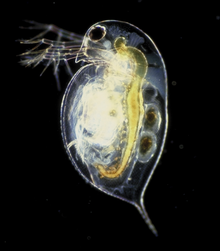Daphnia
Daphnia are small, planktonic crustaceans, between 0.2 and 5 mm in length. Daphnia are members of the order Cladocera. They are one of the several small aquatic crustaceans often called water fleas because of their jumpy swimming style. They live in various aquatic environments ranging from acidic swamps to freshwater lakes, ponds, streams and rivers.[1]
| Daphnia | |
|---|---|

| |
| Daphnia pulex | |
| Scientific classification | |
| Kingdom: | |
| Phylum: | |
| Subphylum: | |
| Class: | |
| Order: | |
| Family: | |
| Genus: | Daphnia Müller, 1785
|
Anatomy & physiology
changeCirculation
changeDaphnia have open circulatory systems. Instead of having blood vessels, the daphnia have a fluid called haemolymph. The haemolymph is pumped throughout the body cavity (which is called a haemocoel).
Nervous system
changeThe Daphnia’s nervous system consists of a brain that has two or three pairs of ganglia. Ganglia are nerve cells that tend to cluster up. The nervous system also has nerve rings that go round the oesophagus. Last of all, it has a paired ventral nerve cord.
Reproduction
changeThe Daphnia reproductive system is parthenogenetic. The female daphnia produce eggs without mating. That means that their eggs can grow without being fertilized. The female daphnia carries its 50 or so eggs in the brood chamber, until they are ready to hatch. Daphnia can still mate, the only difference is that the “mated” eggs have an extra hard shell that can protect them from harsh conditions for a long time. These eggs are called cysts, and they can hatch when conditions are favorable again, which is usually around spring.[2]
Other
changeDaphnia spp. are a popular live food in tropical and marine fish keeping.[3]
References
change- ↑ L. Forró; et al. (2008). Estelle V. Balian (ed.). "Freshwater animal diversity assessment" (PDF). Hydrobiologia. Developments in Hydrobiology 198. 595 (1): 177–184. doi:10.1007/s10750-007-9013-5. ISBN 978-1-4020-8259-7. S2CID 45363782. doi:10.1007/978-1-4020-8259-7_19
- ↑ N.N.Smirnov (2014). The physiology of the Cladocera. Amsterdam: Academic Press.
- ↑ "The amazing Daphnia water flea". AquaDaily. February 16, 2009. Archived from the original on March 3, 2009. Retrieved February 18, 2009.
Other websites
change- Van Bergen, Yfke. 2004. Daphnia breaths easy. Journal of Experimental Biology 207, i-ii [1]